Bury Cottages in Stanborough

They were built in 1921 to house soldiers returning from service in the Great War - 'Homes fit for heroes'!
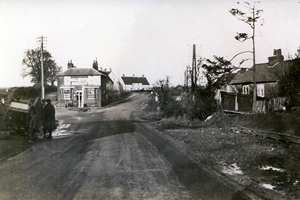 he four pairs of cottages which make up Bury Cottages are situated at Stanborough, Welwyn Garden City on the triangle of land between Brocket Road (B653) to Wheathamptead and Great North Road (B197) to Welwyn, the land was acquired from the Desborough estate. They were built in 1921 to house soldiers returning from service in the Great War - 'Homes fit for heroes'!. Originally they were known as 1 to 8 Bury Crescent but are now known as 1 to 8 Great North Road, except for the people at No 3 who prefer to use the original name. CLICK ON IMAGE TO ENLARGE
he four pairs of cottages which make up Bury Cottages are situated at Stanborough, Welwyn Garden City on the triangle of land between Brocket Road (B653) to Wheathamptead and Great North Road (B197) to Welwyn, the land was acquired from the Desborough estate. They were built in 1921 to house soldiers returning from service in the Great War - 'Homes fit for heroes'!. Originally they were known as 1 to 8 Bury Crescent but are now known as 1 to 8 Great North Road, except for the people at No 3 who prefer to use the original name. CLICK ON IMAGE TO ENLARGE
Water came from a hand pump near the path between Nos. 4 & 5
When first built the cottages had a sitting room, dining room and a small kitchen downstairs and three bedrooms upstairs. Water came from a hand pump near the path between Nos. 4 & 5. Initially there were no mains services but later a single story brick and wood extension was built for a bathroom and toilet. The unusual pinkish floor in the dining room was laid by an Italian firm whose methods were a closely guarded secret.
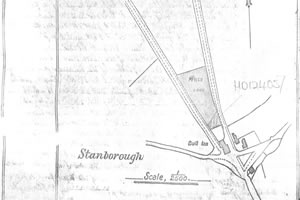
The Indenture, dated 21st December 1919,
between The Right Honourable William Henry Baron Desborough, the Trustees and and the Rural District Council of Hatfield. This is the Deed of Sale by which the plot of land which was owned by the Cowper Estate and upon which Bury Cottages were to be built was bought by Hatfield Council.
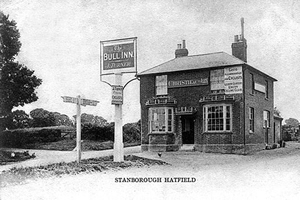
The old Bull Inn was a victim of these changes
crossroads between Brocket Road and Great North Road. However in the 1930s changes were made to the Stanborough crossroads when Stanborough Lane was widened and improved to make better access to the developing Welwyn Garden City. The old Bull Inn was a victim of these changes as it lost land. A larger Bull PH was re-sited on the opposite side of the Great North Road
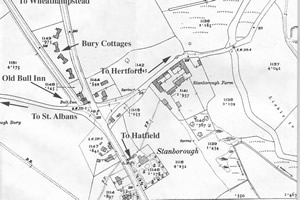
The OS map on the left is from 1923
The OS map on the left is from 1923. It shows Bury Cottages with the old Bull PH next to them at the junction of Brocket Road (now the B653) and the Great North Road (now B197) but no other houses on either road. The map also shows two houses, both long since demolished, on the opposite side of the road, One was the 'Turpins Rest' Tea Rooms run by Miss Tuke. There are several places locally which bear Dick Turpin's name but regretfully it is now thought that he did not operate so far south.
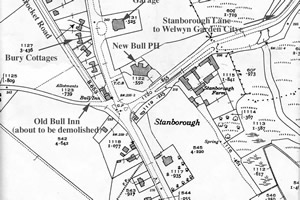
The OS map on the right, dated 1938
The OS map on the right, dated 1938, shows how much the area had become built up since 1923. Opposite the Cottages is the garage and the new building for the Bull PH. The old Bull PH, although still marked, was on the point of being demolished.
The First Tenants of Bury Cottages
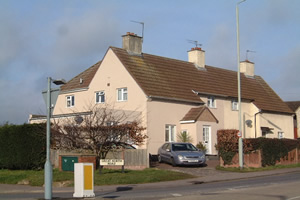
Number 1 Bury Cottages
1922: Thomas William Coleman, wife, Grace Sarah and daughter Elsie Grace,
born November 3rd 1921
War record: No information to date
1924: Henry William Skeggs (1898-1984) living with his wife, Gertrude Emily until 1936, then with his partner: May Caroline from 1937 to 1980
Previous Address: Hatfield.
War record: possibly Private 27027, Bedfordshire Regiment
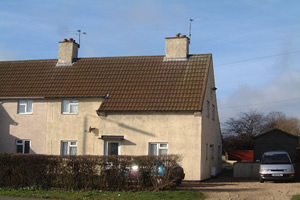
Number 2 Bury Cottages
1922: William Lyon (1884 - 1st October 1971) and wife Rhoda Adelaide
Previous Address: Hatfield
War record: no information to date
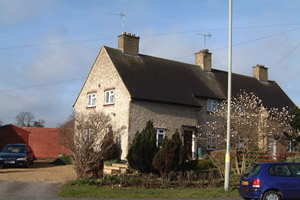
Number 3 Bury Cottages
1922: Walter J Welch (1884 – February 8th 1959), wife Emma Rosina (1903 -October 20th 1993)
1901 Census: House Boy, Domestic Later: Carpenter.
Previous Address: Lemsford
War record: Possibly Private 23458 Bedfordshire RegtMoved to 14 Great North Road

Number 4 Bury Cottages
1922: Samuel John Skeggs (1876 – 1969) and wife Mary Louise
1901 Census: Railway worker. Fireman
Previous Address: Stanborough Area
War record: Bombardier 58078, Royal Garrison Artillery
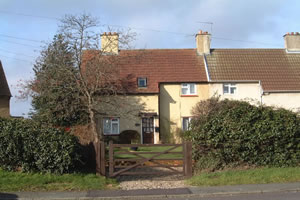
Number 5 Bury Cottages
1922: Arthur Ernest Freeman (1895 – January 3rd 1996), wife Margaret Elizabeth
( 1899 - June 14th 1981 1901Census: Gardener
Previous Address: Stanborough Farm
War record: Sergeant 38476, 162nd Siege Battery, Royal Garrison Artillery
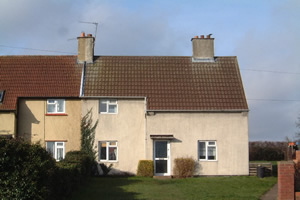
Number 6 Bury Cottages
1922: Augustus Cecil Wren (1895 - ) wife Evelyn
Occupation in 1901: No Record
Previous Address: Lemsford Primrose cottage
War record: Private 12813, 6th Bedfordshire Rgt
Number 7 Bury Cottages
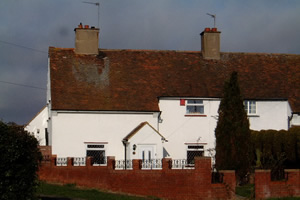
1922:James Walby (1877 – June 4th 1932) and wife Rose
1901 Census: Mechanical Engineer Turner.
Previous Address: Union Street Hatfield
War record: possibly Private 3625, Essex Regiment
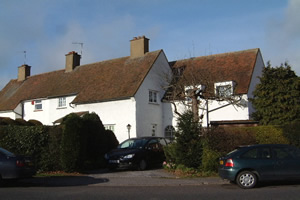
Number 8 Bury Cottages
1922: Frank Lines (1883 – September 1st 1959) and wife Margaret Edith (1882 - September 14th 1961)
1901 Census: Gardener, 1916: Carpenter
Previous Address: Lemsford
War record: Sapper 507700, 1st Docks Rgt. Kings Regt.
1st and 2nd Dock Battalions, Kings Regiments were formed in August 1915
and possibly 1918 respectively, and remained in Liverpool throughout the war
The memories of Pop Freeman who lived at Number 5 by Bill Bates
Number 5 Bury Cottages Though Arthur Freeman who lived at number 5 for 60 years, he was not born in Stanborough, his family moved to a farm (where the sailing lake car park stands) around the turn of the century, where his farther was the manager. Life was tough for a young Arthur who, being the eldest, received regular beatings from his father. He attended St. John’s school up until the age of 12, when after suffering blackouts he went out to work. One of his first jobs was with the gardeners for Lord Mount-Stevens on the Brocket estate and as a hand on the Farm where they lived. One of his regular jobs was to walk livestock to St Albans market every Wednesday, he would say that the first house you would come to in St Albans in those days was the Jolly Sailor Public house. At the age of 15, to escape the tough life at home, Arthur walked to Hertford to enlist into the Army. He lied about his age as minimum age at the time was 16. But he was given a bed for the night and a pen and paper to write to tell his parents where he was.? Arthur loved army life; he was in South Africa on the day the First World War was declared. He recalls that there was a German ship in the harbour of the town where he was stationed at the time. The ship was given time to leave and 24 hour lead before the Royal Navy gave chase (how things would change).? On returning to the UK, the intrepid Arthur went to Wales for Artillery training. During this training an accident happened that caused
several charges to explode, the injuries that Arthur sustained affected his hearing for the rest of his life. In France Arthur was a sergeant in the 162 Siege battery as well as being a first class signaller.? It was this secondary role that was sure to save his life. He shared the role of signalling reports from the front line back to the Battery with another chap, who on one night did not “fancy” taking his turn up the front (possibly due to poor weather) so Arthur duly went, with the help of a “young lad”(who tended to be older than Arthur as he was only around twenty years old). While away the Germans pinpointed Arthur’s Battery and shelled it. They hit the bunker where the Gun crews were sheltering killing all but one person, who was out of the shelter looking for souvenirs at the time. Arthur was gassed, and sustained several shrapnel wounds and saw action at many of the major battles including the Somme, and lost at least one brother in action. Arthur met his “Old Trouble”, (his term) for his wife to be, in London just before he was due to leave the army and was married within a few months (unfortunately the marriage only lasted 62 years). They moved back to Stanborough and rented a room at Bury Farm. A Mr Arthur Freeman and his wife originally moved into No 5 (possibly the first house completed).
When the Second World War rolled along Arthur was to old for active service and also his daytime job and attachment to the St Johns Ambulance Service in Hatfield were deemed important to the war effort. Rooms were rented out in the house at the time and also the house was regularly attended on a Saturday night by the girls from an AA Battery stationed where the police head quarters are now, for a dance in the front room. While in the House Arthur had two main jobs; one was Digging the clay at the Brick Fields where the Gosling stadium now stands and the other at ICI, where he worked until his early seventies. “Art” was a great fellow even well into his nineties he still had the energy to maintain a fabulous flower garden to the front of the house and a fully stocked vegetable garden at the back. Arthur had two children June and Richard, June must have caused some controversy when just after the war she courted and married Ivan Lust a German sailor, who was a POW from the camp near Lemsford Church. Ivan was one of the few survivors of the Bismarck and after a frosty start with Art and a shotgun, he went on to be the “best son-in-law a man could want”. June and Ivan became close associates with Lord Mountbatten of Burma through the North Atlantic Star Association.
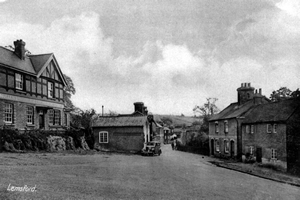
Late in his life Art achieved every working man's dream of being allowed free beer in all McMullen's pubs and even had a 100th Birthday celebration lunch at the brewery (filmed and shown on that nights local news).
Arthur lived in the house for around 75 years. When things were getting too much he moved to his daughters around 1995 The above memories of Pop Freeman was kindly written by Bill Bates. William, as he is known to the older residents of the cottages, lived at number 6. He was born in 1969, the only son of Bill and Sylvia Bates who moved into No 6 in 1965. He was very close to Pop and spent many hours in his company.
The Lines Family at No. 8 Bury Cottages
From 1922 until 1962 Frank and Margaret Lines lived at No 8 Bury Cottages. Both Frank and Margaret grew up in Lemsford. They were married at St. John's Church on May 12th 1913 and are buried in the churchyard, as is their only child, Brenda, tragically killed in a motor car accident when she was only six years old.
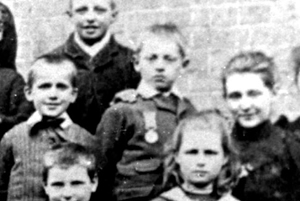
When Frank was only eight he saved a fellow school friend, James Cochrane, from drowning. On the 28th December, 1891 a group of boys were playing on the ice on the Broadwater in Brocket Park. James ran after a ball onto the ice but the ice broke when he was some distance from the bank. He managed to cling to the edge for some time but could not get back onto the ice. The other boys who were present ran away but Frank crawled to the hole and with the aid of a stick got James out. However the ice again gave way again and James fell in once more. Frank tried again and this time successfully. He was awarded a silver medal by the Royal Humane Society for his bravery. Extract from Lemsford school log book March 1892 reads : 'School visited in afternoon by Col. Fellows, Rev. F.E. and Mrs Coggin, and a gentleman. Col. Fellows presented, on behalf of the Royal Humane Society, a silver medal to Frank Lines (St III) for having saved James Cochran (Sic) from drowning'. The Strand Magazine for May 1893 published the story.
The Herts Advertiser for April 29th 1922 report of the inquest on Brenda Lines.
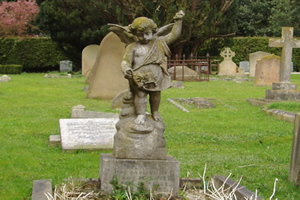
The death of Brenda Edith Lines, the six year old and only daughter of Mr Frank Lines of 8 Bury Crescent, Stanborough, near Hatfield, who reported in last weeks ‘Herts Advertiser’ was run over and killed by a motor car, was the subject of an inquest held by Mr Longmere last Friday. The driver of the Motor car in question, Mr Arthur Charles Davis of 4 Mount Avenue Ealing, stated that he was driving the car on the day in question. Sitting in front with him was his wife, and his two children were behind. On nearing the Bull public house Stanborough, he saw three children run into the road from the right hand side. At the time he was travelling at about fifteen miles per hour. He sounded his horn and felt for his footbrake. Two of the children ran back, but the other hesitated, looked back and then ran straight into the car. The left hand side lamp came into contact with the child, and he imagined it hit her on the shoulder. Witness pulled up in about two lengths, got down from the car and dispatched two persons for a doctor and police. Elaine Davis, wife of former witness, corroborated her husbands evidence, and stated that it was impossible to avert the accident. Emily Woodhouse 48, St Anne’s Road Harrow, who was riding in a car behind that driven by Mr Davis said she saw the accident and corroborated the evidence given by Mr Davis. P.C Hawkins said when he arrived at the scene of the accident the deceased was lying in the gutter on the near side of the road. There was blood coming from the nostril and the left ear and there was blood upon the road here the child was lying. There was no sign of life. Witness examined the car and found that the near front headlamp was completely gone. Later he found a lawn tennis ball lying a short distance away. Dr A. N. Ballance, Hatfield describing the Childs injuries said that he found a bruise about the size of the palm of his hand on the front of the left thigh. Blood was coming from the nostril and the ears. Particularly the left ear. The cause of death was a fracture at the base of the skull. There were also severe internal injuries which could not be determined. The Coroner found that the deceased had died from injuries received by accidentally coming in contact with the motor car in the way described by witness. The funeral took place at St John Church Lemsford On Saturday afternoon. The Revd W.W. Clarke (Vicar) officiated and many relatives and friends attended. The grave was beautifully lined and covered with flowers by Mrs Baily King and Mrs Ladbury. Lady Mount Stephen having sent the flowers for this purpose. The Floral tributes were numerous. Many of the schoolchildren who were on holiday sent wreaths to mark their mourning for their departed playmate.
Herts Advertiser April 29th 1922
The Queen (Mary) paid a visit to Brocket Hall, After lunching with Lady Mount Stephen, her Majesty and her hostess visited Lemsford churchyard, She placed a wreath on the grave (Image of grave above) of Lord Mount Stephen. She also sympathetically inspected the flowers on the grave of little Brenda Lines, the six year old victim of the recent motor car fatality
The archives have a complete list of all tenants up to 2008. Plan below shows where all the above are buried in the graveyard at St John’s, Lemsford
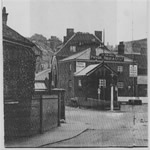
For the most part the cottages were built from recycled timber, bricks and tiles taken when the old Hatfield Brewery was demolished. ?This brewery, situated in Old Hatfield and dating from the time of Henry VIII, was closed in 1920. In 1995 when the outside walls of number 7 Bury Cottages were stripped of their pebbledash facing, the wall beneath was found to have been constructed from bricks and half bricks which had come from the old brewery. For further information about the history of the Brewery see article by By Brian Lawrence Click Here

